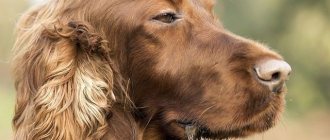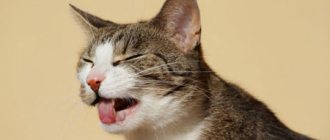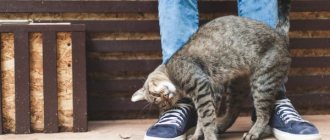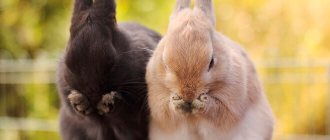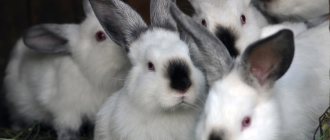Why do rabbits die?
The mass death of all or the sudden death of one rabbit - every rabbit breeder faces this sooner or later. The main reasons are lack of proper care, unsanitary conditions, poor quality feed and dirty water. Keeping long-eared rodents in this manner increases the risk of contracting infectious diseases, as well as diseases that are not transmitted from individual to individual.
To prevent mortality or at least reduce the number of affected animals, you need to know the rules and conditions for keeping rabbits, what diseases they are susceptible to and their symptoms, as well as what preventive actions will protect the livestock from death.
Main causes of death
The most common cause of death is improper keeping of rabbits, carried out in violation of almost all sanitary standards. If you don’t have enough time to promptly clean cages and replace dirty water in the drinking bowl with clean water, be prepared for your pets’ health to deteriorate. The consequences can be very dire for the entire livestock. An important factor contributing to the loss of vitality of individuals is irregular and unbalanced nutrition.
But often rabbits begin to die from attentive owners, despite regular proper feeding, timely cleaning and disinfection of cages. The reason for this is viruses and infections that float in large numbers in the air during the summer. The carrier of such diseases can be not only another animal suffering from it, but also an insect.
Most often, both adult rabbits and young animals get sick:
- VGBK fever,
- Myxomatosis,
- Pasteurellosis,
- Coccidosis,
- Flatulence.
Let's look at each of them in more detail to make the correct diagnosis and understand why your rabbit died.
VHBD, that is, viral hemorrhagic disease of rabbits, is susceptible to individuals older than two months of age. The disease occurs in the form of a severe fever of a contagious type, transmitted through fur, meat, feces and through the air. In most cases, even vaccination does not help save the animal from death, but the worst thing is that in the initial stages the disease is asymptomatic.
And when rabbits begin to refuse to eat, become overly nervous, quickly lose strength and become immobile, convulsively twitching their paws and throwing back their heads, it is already too late, the disease takes on an acute form, and it is too late to take some life-saving action.
Animals suffering from fever have pain all over their body and blood from their nose, which is why they throw their head back so often. Between the time of infection and death there is usually a period of 24 to 72 hours. First, the liver is affected and the liver is destroyed, then the lungs swell, oxygen stops entering the body and the rabbit dies.
What do rabbits get sick with and how to treat them
All diseases of eared pets can be divided into infectious and non-infectious. The former are much more dangerous, because if one individual gets sick, there is a risk that the entire livestock may die.
Why do rabbits die?
Why do chickens die?
Main infectious diseases:
- hemorrhagic disease;
- coccidiosis;
- myxomatosis;
- pasteurellosis;
- stomatitis;
- cysticercosis;
- tularemia;
- listeriosis.
About some of them in more detail:
Hemorrhagic disease (HDD)
One of the most common diseases. Its other name is fever. Transmitted by airborne droplets (APC), through feces, and contaminated food. The disease can be acute or completely asymptomatic. Most often, infection occurs in the summer. The rabbit dies a day after infection. There are no effective treatments. As a preventative measure, animals need to be vaccinated: the first time every 1.5 years, then every six months.
Important! An unexpectedly dead animal must be taken for an autopsy. If you don’t find out why the rabbit died, you could lose your entire livestock!
Coccidiosis
The causative agent is coccidia, which affects the intestines and liver. Animals become infected through poor-quality food, dirty water and feces. The carrier can be humans or other domestic animals. A sick rabbit loses its appetite, loses weight, its stomach begins to swell, and diarrhea begins. For treatment, animals need to be given antibacterial drugs. As a preventive measure, it is necessary to observe hygiene standards in the rabbitry, disinfect equipment and cages. Dead rabbits should be burned.
Coccidiosis
Myxomatosis
The most dangerous disease. VCP is transmitted, as well as through the bites of mosquitoes and other insects. A nursing rabbit infects her baby rabbits through her milk. At first, the disease is asymptomatic, then bumps form in the area of the head and ears, purulent discharge is observed from the eyes, and the animal begins to develop a fever. The duration of the disease is from 1 to 2 weeks. Death occurs in 95% of cases. There is no effective treatment. The only way to stay safe is through vaccination.
Pasteurellosis
A viral disease transmitted through the air, food, water and humans. Manifests itself in the form of coughing, sneezing, difficulty breathing. The rabbit loses its appetite, the temperature rises, and purulent discharge from the oral cavity appears. If treatment is not started, the animal will die. Antibiotics and sulfonamides help well. With timely veterinary care, rabbits survive. As a preventive action - vaccination from one month of age. Adults - twice a year.
Myxomatosis in rabbits
Stomatitis
A viral disease in which there is increased salivation, swelling of the tongue, and redness of the oral mucosa. Loss of appetite is accompanied by lethargy and sudden weight loss. Treatment is carried out as prescribed by a veterinarian. Failure to provide medical assistance to your rabbit will result in its death.
Cysticercosis
The cause of the disease is cestode larvae, which infect the liver and contribute to the occurrence of peritonitis. The disease cannot be treated and the animal dies. Diagnosed after death. The corpse is burned.
Cysticercosis
Tularemia and listeriosis
Although these diseases are not similar, they have something in common:
- Carriers are rats, fleas, bedbugs, and ticks.
- The disease has no cure.
- Diagnosis can only be made at autopsy.
- Carcasses must be burned.
Note! Listeriosis is dangerous for humans, so if the autopsy diagnosis is confirmed, the remaining individuals that had contact with the deceased rabbit must be destroyed!
The most common diseases of adults and young animals
Infectious diseases pose a danger not only to young animals, but also to adults. They are quickly transmitted from one rabbit to another, resulting in mass death. Such diseases include:
In addition to infections, the death of long-eared pets can be caused by flatulence, as well as other diseases - mastitis in rabbits, ticks, injuries, poor nutrition. Let's look at each ailment in detail.
VGBK (fever)
Rabbit viral hemorrhagic disease is easily transmitted to healthy individuals. It is caused by a highly virulent RNA virus. Another name for this disease is necrotizing hepatitis. The incubation period of the disease is 1-5 days. Sometimes the infection progresses so quickly that the farmer may not notice any changes in the behavior of the rabbits until he discovers dead animal carcasses at the next feeding.
VGBV is transmitted through nutritional and respiratory routes. The mortality rate reaches 90%; rabbits die within a day or three after the first alarming symptoms appear. In hyperacute cases, death occurs within a few hours. Among the main symptoms are:
- oppression;
- refusal of food;
- convulsions;
- moans;
- just before death, blood is released from the nose.
Vaccine against VGBV
There is no cure for VGB. A special vaccine, which must be administered annually to adults, helps protect livestock from the virus. Rabbits are vaccinated at the age of 45 days.
Myxomatosis (distemper)
This disease is of viral origin. The disease is highly virulent. Most often, outbreaks of myxomatosis occur in the warm season, since insects are one of the sources of its spread. This is one of the reasons why rabbits die in the summer. A healthy pet can become infected with a disease through contact with a sick animal or one that has already suffered from this disease. The incubation period lasts from 2 days to 3 weeks. Symptoms of myxomatosis:
- The appearance of red spots and nodules resembling tumors in the head or genital area. The head increases in size, folds form on the skin.
- Purulent discharge from the eyes, nose.
- Labored breathing.
Adults die within 2 weeks, young animals die faster - in 5-7 days. Treatment for myxomatosis has not yet been developed. To prevent the disease, vaccination is used.
Attention! The associated vaccine contains strains of myxomatosis and VGBV. It can be administered to rabbits starting from one and a half months of age.
Pasteurellosis
This disease is caused by Pasteurella bacillus and affects the upper respiratory tract of animals. The disease usually occurs in two forms - acute or chronic. In acute cases, pasteurellosis manifests itself as:
Pasteurellosis in a rabbit
- a sharp increase in temperature to 41 degrees;
- sneezing, mucus discharge from the nose;
- the pet does not eat, he is very depressed;
- intestinal upset is observed.
Attention! If pasteurellosis is acute, death occurs within 2 days after the first symptoms of infection appear.
The chronic form of the disease is characterized by the following symptoms:
- signs of conjunctivitis;
- mucous discharge from the nose, sneezing;
- watery diarrhea;
- Abscesses appear on the skin.
Despite the high mortality rate (from 15 to 75%), pasteurellosis can be cured. To stop the mortality of rabbits, it is important to begin therapy immediately. Antibiotics and sulfonamide drugs are used against this disease - tetracycline, norsulfazole, oxytetracycline, chloramphenicol. The course of treatment can be 4-9 days, depending on the form of the disease.
Attention! To prevent pasteurellosis, a special serum is used. It can be used for rabbits older than three weeks of age. If pets are one and a half months old, a formol extract vaccine is used.
Coccidiosis
The causative agents of this disease are protozoa - coccidia. They affect the liver and intestines of animals. Intestinal coccidiosis is more acute than hepatic coccidiosis. Infection occurs through the nutritional route, that is, through the digestive system. Small rabbits can become ill from their mother's milk if she is a carrier of coccidia.
Symptoms of the disease are pronounced, especially in the intestinal form:
- loss of appetite;
- intestinal disorder (diarrhea gives way to constipation);
- elevated temperature;
- exhaustion;
- bloating.
Attention! Symptoms of hepatic coccidiosis are less severe, but they are accompanied by yellowing of the mucous membrane of the eyes.
Treatment should be started immediately. For this use:
Iodine is also used to treat and prevent coccidiosis. It is diluted in water according to a certain scheme and given to the rabbits to drink.
Flatulence
Bloating most often occurs in small rabbits, because their digestive system is imperfect and very sensitive. Babies recently weaned from their mother are at risk. Any mistake in nutrition can lead to bloating. Causes of flatulence:
- feeding rabbits wet grass;
- ingestion of hairballs;
- sudden change in diet;
- imbalance of microflora.
Flatulence in a rabbit
Symptoms of the disease are an enlarged abdomen, a depressed state, teeth grinding, refusal to eat, and the rabbit does not go to the toilet. This is a very dangerous condition, since in rabbits feces move through the intestines due to the arrival of new food. In these animals, intestinal peristalsis is very weak. If the pet does not eat, the intestines stop working and fermentation processes begin in it. As a result, the rabbit may die from intoxication.
You can help an animal with flatulence with an enema, abdominal massage, and also by giving it vegetable oil to drink. If the pet does not eat on its own, you need to feed it liquid food from a syringe and give it water.
Attention! Refusal to drink can lead to death, so they resort to subcutaneous injections of Ringer's solution. It is administered every 3-4 hours, 10 ml, until the rabbit begins to drink on its own.
Other reasons due to which livestock die
Female rabbits often suffer from mastitis . This disease is characterized by inflammation of the mammary gland. It occurs due to injury to the nipple or due to stagnation of milk, for example, after weaning rabbits. If the inflammatory process is started, pus may accumulate in the mammary gland, then it is unlikely that it will be possible to avoid the spread of infection throughout the body. Mastitis is treated with antibiotics, lotions, ointments - ichthyol, tetracycline, etc.
Non-infectious diseases of rabbits
Why do chickens die
In addition to viral diseases, the life and health of rabbits can also be threatened by non-infectious diseases. As a rule, they do not cause mass mortality, but the death of even one head causes a lot of trouble for the rabbit breeder. The most common ailments:
- Flatulence. It occurs due to an excess of succulent feed, wet grass and the presence of mold in it. The rabbit loses its appetite, the mucous membranes turn blue, and rapid breathing is observed.
- Avitaminosis. Develops with unbalanced food and vitamin deficiency. Observed: hair loss on the back, bleeding gums, dry eyes, growth retardation.
- A rabbit can get heatstroke if the rabbitry is not ventilated and the temperature in it is higher than the required level. The animal becomes lethargic, constantly lies and breathes heavily.
- Trauma. Scratches, abrasions, bruises, and finally, broken limbs - all this is the result of overcrowding of cells, the presence of traumatic equipment in them - feeders or drinking bowls with sharp corners.
- Parasites. Most often, ear mites cause discomfort to the animal. Their presence is indicated by itching and redness of the ears. The rabbit begins to lose hair, loses weight, and develops general weakness and exhaustion
- Mastitis. If the cage where the nursing rabbit is kept is constantly damp and not cleaned, then microbes enter the body through microcracks in the nipples, which can lead to inflammatory processes in the body of varying severity.
These diseases cannot cause instant death, are not epidemic in nature and do not arise suddenly. They appear due to improper feeding and maintenance of rabbits, and the farmer’s lack of the necessary knowledge and experience. If neglected, they will ultimately lead to the death of the animal.
What to do if pestilence of young animals begins
Video: Why do chickens die
If trouble does come to the rabbitry, and young animals begin to die for no apparent reason, and the farmer does not know why the young rabbits are dying, then, without wasting time, you need to act:
- Isolate from the population any individuals that look suspicious. It is advisable to remove them not just to other cells, but to another room.
- Then you need to find out why the rabbits are dying. To do this, the dead rabbit carcass must be taken to a veterinarian for an autopsy.
- After receiving a conclusion about the cause of death, proceed either to treatment (if the disease is curable) or to the destruction of infected individuals.
- The remaining young animals should be quarantined under close supervision.
- Treat the cages where sick individuals were kept with a disinfectant.
Why do little rabbits die?
All mammals during their milking years rarely die from disease, and baby rabbits are no exception. The fact is that at birth, and then with mother’s milk, babies receive a significant portion of immunity. The mortality rate from infectious diseases in rabbits during the suckling period is extremely low.
Why do little rabbits die?
Such a misfortune can happen if the rabbit herself is already infected with the virus and is its carrier. She can become infected both during pregnancy and after giving birth. An example is the coccidiosis virus. A female rabbit can get sick after receiving contaminated food, and then pass the infection to her babies through her milk.
Note! But not only mother's milk can lead to the death of newborn animals. The reason why baby rabbits died was often dampness in the nest (in autumn) or cold (in winter). If the queen cell is kept in unsanitary conditions, then various cocci, for example, staphylococcus, may appear there. Such an infection is detrimental to small rabbits.
Another cause of death for baby rabbits is rats. These omnivores are not averse to feasting on a defenseless rabbit. And very often it happens that all the cubs from the birth go to be eaten by these rodents. Therefore, it is very important to carry out regular disinfection and other measures to combat rats in the rabbitry. Some farmers even get burrowing dogs to fight them.
Every rabbit breeder should clearly know what to do if their rabbits die. Measures must be taken immediately, otherwise you may be left without offspring altogether.
Why do decorative rabbits die?
Recently, it has become very popular to have decorative rabbits as pets. And not everyone knows how to keep them, how to feed them and how to take care of their health.
These fluffy creatures were first noticed at the end of the 19th century. Then they began to be bred for their fur. At the end of the 30s. last century, the first breed standards appeared. They began to be imported en masse to Russia after 1995.
For your information! Now there is a huge variety of breeds of decorative rabbits. Among them there are giants weighing up to 8 kg, and very miniature ones, whose weight does not exceed 1 kg. There are real shaggy ones and completely smooth-haired ones. Some have long ears that hang to the sides, while others have very short ears that stand upright.
Decorative rabbits, like ordinary rabbits and their wild counterparts, have nothing to do with hamsters, guinea pigs and other rodents. And their content requirements are different. They become very attached to people, love when they are given attention and do not tolerate loneliness very well. Because of this, they may even get sick and die. The first signs that something wrong is happening appear in their behavior:
- the rabbit refuses to eat;
- reluctant to leave the cage;
- his movements become sluggish and heavy.
When breeding decorative rabbit breeds, attention was paid to appearance. No one was involved in selecting producers based on character. Therefore, today's descendants of old breeds have individuals with completely different types of nervous systems: from cute, affectionate creatures to grumpy, pugnacious and even aggressive types.
Why do decorative rabbits die?
Pets can get sick from the same infectious diseases as their fellow tribesmen living on rabbit farms. The same symptoms, the same duration of illness, unfortunately, the same outcome. But, in order to avoid infection, the same prevention is carried out.
Important! Decorative rabbits simply need to be vaccinated! An unvaccinated animal can pose a direct threat to the health of the people around it!
There is another reason why rabbits of decorative breeds die, this is natural death from old age. A rabbit's life lasts 8-10 years. On farms, animals are not kept until this age, but a pet can easily live to a ripe old age. Signs of his veteran age:
- refuses to play;
- a saggy belly appears;
- the lenses of the eyes become cloudy;
- wool falls out.
A rabbit in old age needs increased attention and increased care. The diet must also correspond to his “status”.
Methods for treating and preventing diseases
- It is impossible to get rid of VGBV and myxomatosis, so preventive vaccination of rabbits at an early age is necessary. Subsequently, vaccinations must be done every year. Vaccinated rabbits and female rabbits live to a ripe old age, but it is absolutely pointless to treat sick individuals and they live for a maximum of a month after infection.
- You can get rid of pasteurellosis using one of the antibiotics and B vitamins. If the disease is detected in the first month, the chances of recovery are much greater.
- To eliminate coccidosis, use trichopolum, sulfadimezine, and chemical coccide. At the same time, it is very important to constantly monitor the pet’s well-being and examine their skin every day.
Now you know what needs to be done if the number of rabbits has become dramatically different - not native, sickly.



